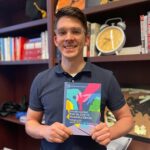
Professor Baird publishes investigation into body awareness of undergraduate dancers

Emily Baird, visiting assistant professor of theatre and dance at The College of Wooster, published an article this spring in the Journal of Dance Education, a peer-reviewed journal in the field. The article, “A Qualitative Investigation of What ‘Body Awareness’ Means to Dancers at A Public Midwestern University,” is an analysis of collegiate dancers’ experiences with and perceptions of somatic movement. In her research, Baird investigates how undergraduate dancers think about the idea of “body awareness.”
“It’s a term that is used frequently in the dance world,” said Baird, “but there is no set definition, and dancers rarely receive any formal education in the area.” She was interested in how undergraduate dancers who weren’t dance majors considered and incorporated the idea into their own dance practices.
Baird’s research is closely connected to somatic movement, a field of techniques that focus on internal sensation as opposed to external aesthetics during movement. “Sometimes the dance world asks students to push their bodies to extremes without concern for how that kind of training can affect a person over a lifetime.” explains Baird. Research has linked dance, especially dance with a focus on external aesthetics, to increased risks to disordered eating, self-scrutiny, and injury. “I am always trying to tell my students to listen to what their body is telling them,” Baird said. “When we aren’t in tune with our bodies, we make ourselves more susceptible to injury, exhaustion, burnout, etc.”
To better understand how undergraduate dancers think about somatic movement and body awareness, Baird conducted interviews with eight undergraduate students who were dancing at the collegiate level but weren’t majoring in dance. The results showed that the dancers viewed body awareness as a complex process of mirroring, noticing, knowing, and controlling the body. Many dancers had experiences with practices related to somatics, like yoga, or experienced injuries that had taught them more about their body’s structure and limits, but all had limited formal experience with somatic practices. However, when the students did reflect on their experiences in the area, they overwhelmingly described these experiences as positive.
Baird says her research is one of the first studies to ask these questions of collegiate dancers that hadn’t taken some sort of specialized course in body awareness, somatics, or functional anatomy. She also intentionally worked with dancers who were not majoring in dance. “I think it’s important to remember that there are so many people that dance at a high level but never complete an academic major in dance,” said Baird. “They are also deserving of dance environments that prioritize healthy and enjoyable movement.”
Connecting the results of her study back to her own students and classes, Baird says her research has allowed her to learn more about how her students “are entering class, what prior experiences they’ve had in their lives, or perhaps how they’re used to thinking about their relationship to their body.” Baird hopes to expand on this research in the future. “I think there is always room to talk more about how we can take care of ourselves and move our bodies in a way that feels good.”
Posted in News on April 25, 2022.
Related Posts
Related Areas of Study
Theatre & Dance
Scholarship and artistry in theatre and dance for those who are passionate about performance in all its forms.
Major Minor

